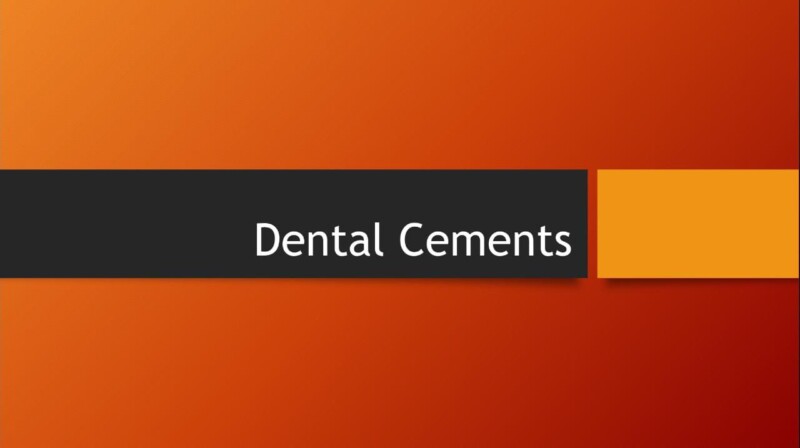What are dental cements?
– Material formed by mixing powdered oxide and acidic liquid (except for resin cements)
What are the general characteristic of dental cements?
– Hard and brittle
– Low strength compared to the restorative material
– Soluble in oral fluid
What are the main uses of dental cements?
1) As Luting agent for cementation
– Dental cements are used for retention of cast restoration on prepared teeth. It can be either permanent cementation or temporary cementation.
– Permanent Cementation
: A long term cementation for permanent restorations such as inlays, on-lays, crowns, bridges, laminate veneers and orthodontic brackets.
– Temporary Cementation
: Short term cementation (2-3 weeks) for placement of temporary restoration to prevent the prepared tooth from moving until the permanent restoration is done.
2) As Bases
– Thick layer of cement (1-2 mm) applied under the restoration
– To prevent thermal, electrical and mechanical stimuli which will irritate the pulp. (Act as insulator)
– It is strong enough to support restoration so it will not fracture under the force of mastication.
3) As Liners
– Thin layer of cement (0.2-1 mm) placed between the base of the cavity and the pulp.
– Its function is to seal the dentinal tubule and protect the pulp from the restoration to prevent chemical irritation to the pulp.
– The strength of the liners is not necessary as it will be covered by the cement base which is strong enough to withstand the force of mastications.
4) Direct Restorative
– Dental cements are also used as direct restorative but only in cavity with non-stress bearing area such as class III and class V restorations.
What are the other uses of dental cements?
1) Temporary filling materials
– Dental cements are placed in the prepared teeth to relieve the pain before permanent restorations are made.
2) Cementation of orthodontic brackets
3) Periodontal surgical dressing
– Dental cements are used to cover the wound after treatments to prevent contamination and pain during eating or drinking
– It will also decrease inflammation as well as promote healing of the wound.
4) Pulp capping material
– When the caries in ones tooth is too deep, pulp capping is done by using the dental cements to promote healing of the pulp.
5) Root canal sealer
– This is done after the removing the pulp in root canal treatment before filling the tooth with gutta percha.
What are the requirements of a dental cements?
Generally, a good dental cements must be:
1) Non toxic and non irritant to the pulp and oral tissues
2) Insoluble in oral fluids
3) Have antibacterial effect
4) Have obtundent effect (able to blunt irritation or lessen the pain)
5) Easily manipulated by having adequate working time and not technique sensitive
6) Adhere to tooth structure and restorations by chemical bond
7) Not expensive
If the dental cements are to be used as luting cements for cementation, they must be:
1) Have sufficiently low initial viscosity to have good flow and good wetting, thus will give low film thickness and adequate working time in oral cavity temperature to permit the placement of restorations.
2) Have high mechanical properties (compressive strength, elastic modulus, fracture toughness) to resist the force of mastication.
3) Have optical properties similar to the tooth structure for cementation of translucent restoration.
If the dental cements are used as cavity bases and liners, the requirements needed are:
1) Thermal insulation to protect the pulp from temperature change when large metallic restoration (amalgam) is made.
2) Chemical protection to prevent penetration of the harmful chemicals from the restorative material to the pulp.
3) Electrical barriers against galvanism
4) High modulus of elasticity to prevent fracture due to force of mastication
5) Rapid setting to permit packing of filling material
6) Adequate compressive strength to allow condensation of filling material
7) Structural integrity to allow distribution of the force of mastication
What are the classifications of the dental cements?
The dental cements are classified according to ingredients or water content amd according to setting reaction.
According to ingredients and water content, there are:
1) Water-based cements such as zinc phosphate, glass ionomer cement and zinc polycarboxylate
2) Oil-based cement such as zinc oxide eugenol
3) Resin-based cement such as resin cements
According to the setting reaction, there are:
1) Acid-base reaction cements or conventional cements such as zinc phosphate, glass ionomer cement, resin cement, RMGI cement and zinc polycarboxylate
2) Polymeryzation reaction
3) Dual cure reaction
Contributor- Medico Umairah Zulkifli




